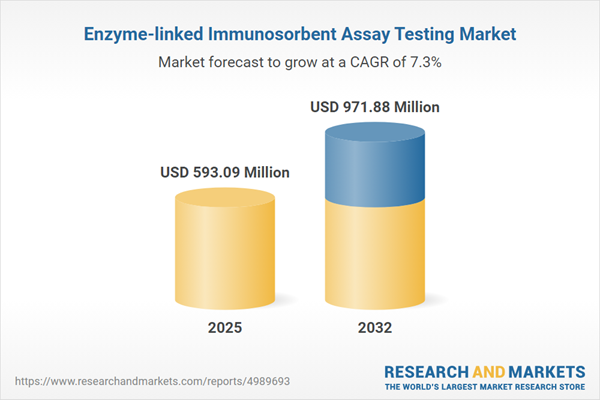Speak directly to the analyst to clarify any post sales queries you may have.
The enzyme-linked immunosorbent assay (ELISA) testing market stands at the intersection of diagnostic innovation, regulatory shifts, and digital transformation, making it essential for senior leaders to anticipate and respond to pivotal industry changes.
Market Snapshot: Growth Drivers and Competitive Landscape
The enzyme-linked immunosorbent assay testing market is advancing at a steady compound annual growth rate, reflecting a sector propelled by ongoing scientific advances and increasing analytical demands. Sustained investments across healthcare, pharmaceutical, and environmental sectors are stimulating the adoption of automated assay platforms, highly specific reagents, and advanced data analytics. The market demonstrates strong traction worldwide, with contributions from both established suppliers and emerging manufacturers. Decision-makers prioritize scalable technologies that offer workflow flexibility and compliance with evolving regulations. Regional variations, regulatory frameworks, and supply chain dynamics continue to shape procurement strategies on a global scale.
Scope & Segmentation: Comprehensive Market Coverage
- Product Types: Microplate readers, microplate washers, automated kits, manual kits, antibodies, enzymes, substrates, data analysis software, maintenance services.
- Assay Formats: Competitive, direct, indirect, sandwich.
- End User Profiles: Academic and research organizations, contract research organizations, hospitals and diagnostics labs, pharmaceutical and biotech companies.
- Application Domains: Disease testing, drug discovery, environmental testing, food safety and quality.
- Regions Covered: Americas (North America, Latin America), Europe, Middle East, Africa, and Asia-Pacific. Sub-regional insights include the US, Canada, Brazil, UK, Germany, China, India, Japan, South Korea, among others.
- Companies Profiled: Thermo Fisher Scientific Inc., Danaher Corporation, Merck KGaA, Bio-Rad Laboratories, Inc., Agilent Technologies, Inc., PerkinElmer, Inc., Bio-Techne Corporation, Becton, Dickinson and Company, Abcam plc, Enzo Biochem, Inc.
Key Takeaways: Strategic Insights for Decision-Makers
- ELISA remains a foundational asset for both routine diagnostics and complex biomarker discovery, supporting a shift toward integrated lab workflows.
- Automation and digital analytics are redefining laboratory operations, redirecting skilled teams to focus on protocol innovation and advanced data interpretation.
- Partnerships between instrumentation, reagent, and software providers are fostering interoperable ecosystems and catalyzing innovation in assay customization and maintenance.
- Regional strategies are crucial as localized manufacturing and regulatory changes impact market entry, supply reliability, and delivery timelines.
- Cross-sector collaboration accelerates assay development, validation, and deployment, especially in response to emerging public health and food safety challenges.
Tariff Impact: Supply Chain & Cost Structure Shifts
New tariff measures in the United States have introduced added complexities for market participants. Import duties on key assay components such as microplate readers and reagent kits are elevating capital and operating costs. Organizations are adopting vertical integration and exploring alternative sourcing models to enhance supply chain resilience. These developments also encourage closer partnerships for co-development and collaborative supply network management. Domestic manufacturing is expanding, yet it brings new considerations around cost structure and scalability.
Methodology & Data Sources
This report combines primary insights from interviews with academic, industry, and regulatory stakeholders, with secondary analysis from scientific literature, patent databases, and market filings. Quantitative methods include time series analysis and consumption pattern review, while expert panels contribute to qualitative validation and regional relevance assessment. This multi-modal approach ensures robust accuracy and relevance.
Why This Report Matters
- Enables informed capital allocation and procurement strategy by mapping technology trends, market segments, and regulatory shifts impacting ELISA adoption.
- Supports executive planning by clarifying the potential of automation, digital analytics, and partnership models across diverse application domains.
- Guides strategic entry and expansion by outlining regional nuances and identifying market opportunities aligned with local infrastructure and demand profiles.
Conclusion
The enzyme-linked immunosorbent assay testing market is evolving with rapid technological advancements and changing global dynamics. This analysis equips senior leaders to optimize operational efficiency, forge meaningful collaborations, and pursue measured growth aligned with current and anticipated trends.
Additional Product Information:
- Purchase of this report includes 1 year online access with quarterly updates.
- This report can be updated on request. Please contact our Customer Experience team using the Ask a Question widget on our website.
Table of Contents
3. Executive Summary
4. Market Overview
7. Cumulative Impact of Artificial Intelligence 2025
Companies Mentioned
The companies profiled in this Enzyme-linked Immunosorbent Assay Testing market report include:- Thermo Fisher Scientific Inc.
- Danaher Corporation
- Merck KGaA
- Bio-Rad Laboratories, Inc.
- Agilent Technologies, Inc.
- PerkinElmer, Inc.
- Bio-Techne Corporation
- Becton, Dickinson and Company
- Abcam plc
- Enzo Biochem, Inc.
Table Information
| Report Attribute | Details |
|---|---|
| No. of Pages | 197 |
| Published | October 2025 |
| Forecast Period | 2025 - 2032 |
| Estimated Market Value ( USD | $ 593.09 Million |
| Forecasted Market Value ( USD | $ 971.88 Million |
| Compound Annual Growth Rate | 7.3% |
| Regions Covered | Global |
| No. of Companies Mentioned | 11 |









